What Observations on Color Were Incorporated Into Impressionist Art
The top Impressionists have had a tremendous influence on my personal development as an creative person. They tested the boundaries of what is possible with colour and demonstrated that subject field matter is non the be-all and end-all in painting. They showed y'alltin pigment something only because it is pretty, without any deep underlying meaning, and you lot can take success doing so.
John Singer Sargent explains Impressionism well:
"Impressionism was the name given to a certain class of observation when Monet, not content with using his eyes to run across what things were or what they looked like as everybody had done earlier him, turned his attention to noting what took place on his own retina (as an oculist would test his own vision)." John Singer Sargent
In this article I provide you with an overview of the Impressionist art movement and some of the fundamental takeaways which you can apply to your ain paintings.
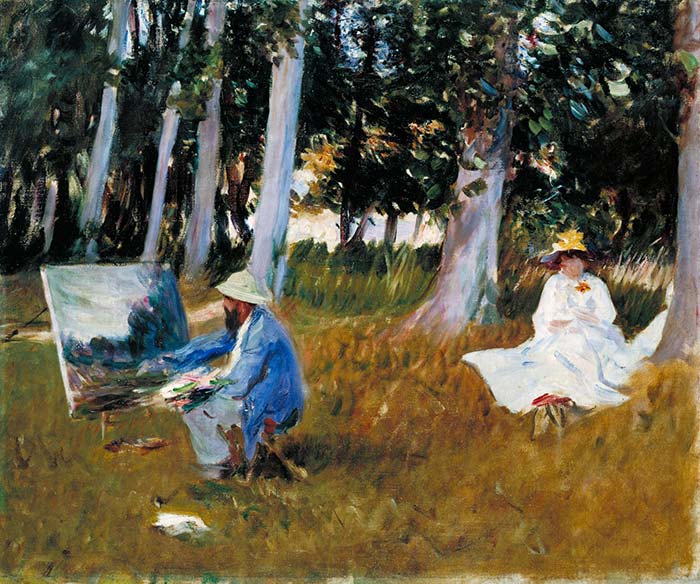
John Vocaliser Sargent, Claude Monet Painting by the Edge of a Woods
The Beginning Of Impressionism
The Impressionist art motility was established in the 1860s, France and represented a radical shift from the realistic academic painting that had dominated the era. Depictions of religious themes and historical subject matter, painted with precise castor strokes and restrained colors were highly valued among the art critics of the time.
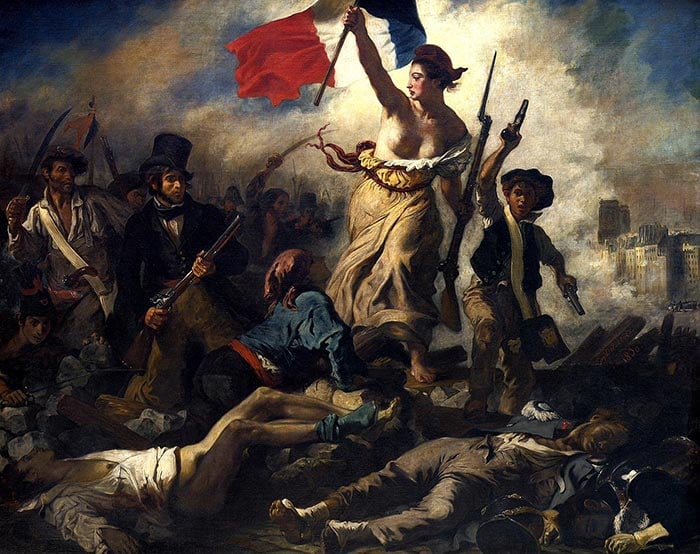
Eugène Delacroix, Liberty Leading the People, 1830
The motility was led by artists Claude Monet, Pierre-Auguste Renoir, Alfred Sisley, and Frederic Bazille who took their canvases outside and established the practice of plein air painting. Their piece of work coincided with the development of portable paint tubes and box easels.
Different other artists, who just made sketches outdoors and then continued to piece of work on them in the comfort of their studios, these iv artists painted plein air from kickoff to finish, depicting vibrant landscapes and capturing the scenes of everyday life. They painted the world as they saw information technology - imperfect and in constant change. As a upshot, their paintings seemed messy and unfinished to other artists at the time.
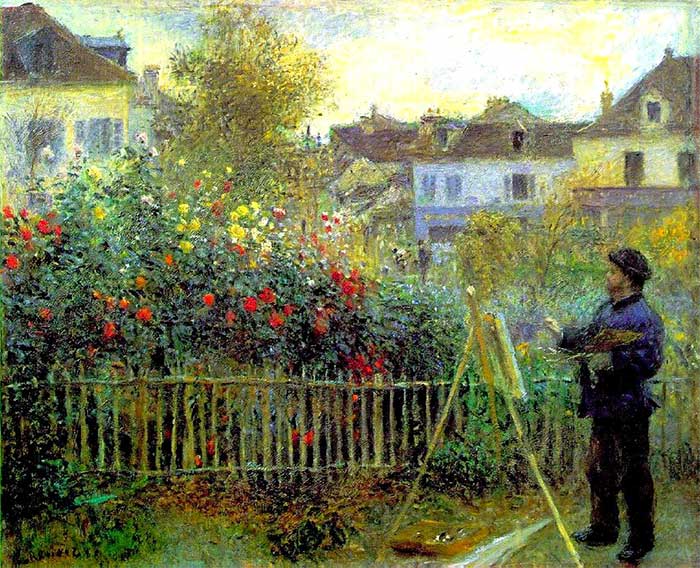
Pierre-Auguste Renoir, Monet Painting in His Garden at Argenteuil, 1873
The movement defenseless public attention in 1874 when Impressionist'south artworks were exhibited at now-famous Salon des Refusés, which is French for "exhibition of rejects". This was a group show equanimous of artworks that were submitted for the almanac land-sponsored exhibition the Salon, but were rejected by the jury.
The official Salon was a prestigious art exhibition held by the Académie des Beaux-Arts in Paris. After many artists were rejected from the Salon, they protested and this reached French Emperor Napoleon III. The Emporer ordered that the rejected pieces should be displayed at a carve up show nearby. The Emporer's office issued the following statement:
"Numerous complaints have come up to the Emperor on the discipline of the works of art which were refused by the jury of the Exposition. His Majesty, wishing to let the public judge the legitimacy of these complaints, has decided that the works of art which were refused should be displayed in another function of the Palace of Industry." (Published in Le Moniteur on 24 April 1863)
The exhibition attracted numerous visitors, art critics and public alike, simply the artworks were mostly ridiculed. In a rather harsh review past fine art critic Louis Leroy, he mockingly referred to the movement as i mpressionist, the name coined after the title of Monet's painting Impression, Sunrise. Little did he know that the word he used every bit an insult would marker the whole art movement.
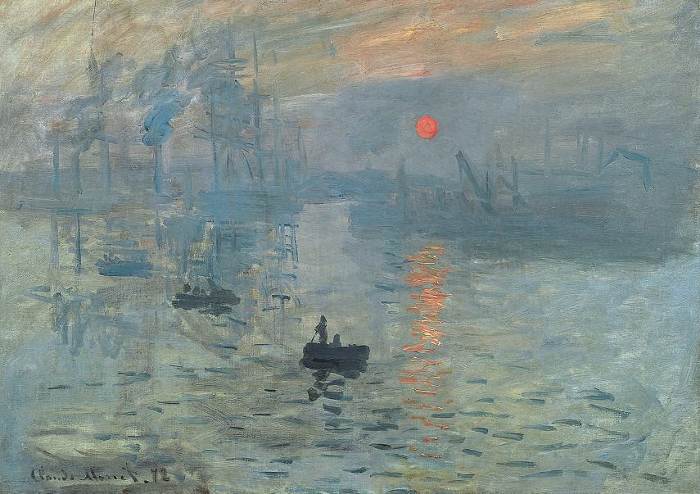
Claude Monet, Impression, Sunrise, 1872
Defining Characteristics of Impressionism
The Impressionist movement was marked by a set of distinctive characteristics that represented a radical change in the way art is made and understood.
Conspicuous Brushstrokes
Before Impressionism, painters used precise, near invisible brushstrokes often composite together with golden varnish. The Impressionists, on the other mitt, used thick, conspicuous strokes to describe the ephemeral nature of light and the passing of time.
Using loose brushstrokes enabled them to paint quickly on the spot and capture the essence of the field of study matter earlier the light changed or the subject moved. This kind of brushwork resulted in energetic paintings which portrayed the fleeting nature of the environment.
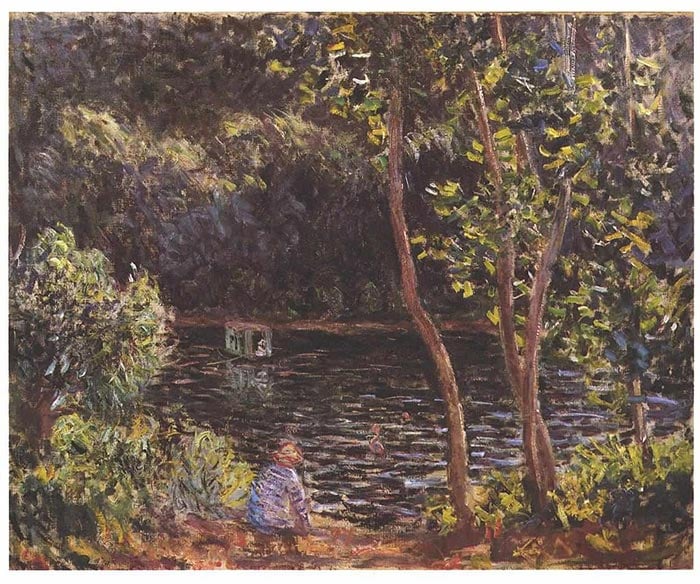
Claude Monet, The Atelier Boat, 1875-1876
Brilliant and Assuming Color Palette
The Impressionists were revolutionary with their arroyo to color. Instead of mixing several paints together to reach the desired tone, the Impressionists often used clean, unmixed colors and grouped them together in an array of small brushstrokes to achieve the desired tones. These various colors optically blend together when viewed from afar. Although the Impressionists did not create this technique, they appear to be the start artists who used it equally a key feature. As John Singer Sargent explained:
"The addiction of breaking up one's colour to make information technology brilliant dates from farther dorsum than Impressionism - Couture advocates it in a little book chosen 'Causeries d'Atelier' written virtually 1860 - it is role of the technique of Impressionism but used for quite a unlike reason." John Vocaliser Sargent
As we can see in this gloomy depiction of a train station in Saint-Lazare, Monet combined emerald green, ultramarine, cobalt blue and even shades of yellow to create a vibration of color:

Claude Monet, Arrival of the Normandy Train, Gare Saint-Lazare, 1877
The Impressionists as well started to innovate more than color when painting shadows. Instead of using blacks and browns, the Impressionists started incorporating blues, greens, purples and other colors with a distinct color tree. This may be due to most of the Impressionist paintings existence created outside, where there is much more light and therefore more than visible color. Or possibly it was due to a great agreement of how light and color piece of work.
The Fleeting Nature of Calorie-free
Plein air painting immune the Impressionists to closely study natural light and the way information technology influences the colors we use. Faithfully painting the light was a master goal of the Impressionists. That was more important than the subject itself in near cases. Back then, calorie-free and color were still a chip of a mystery (and withal are).
In doing then, many artists painted the aforementioned subject matter over and over once again under dissimilar calorie-free and weather atmospheric condition. Claude Monet did this on many occasions with haystacks, h2o lilies and the Rouen Cathedral.
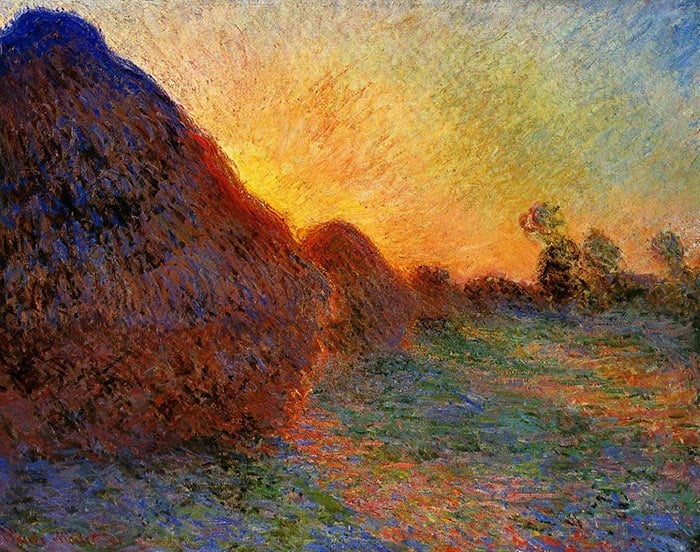
Claude Monet, Haystacks, 1891
Depictions of Ordinary Subjects
The rise of plein air painting in many ways determined the subjects which the Impressionists painted. Instead of grandiose historical or mythological themes, the Impressionists portrayed things they could see outside - typically an array of vivid landscapes, even so lifes and scenes of everyday leisure activities (due east.g. picnics, boat rides...).
As Pierre-Auguste Renoir said:
"What seems most significant to me almost our movement [Impressionism] is that nosotros have freed painting from the importance of the subject. I am at freedom to paint flowers and call them flowers, without their needing to tell a story." Pierre-Auguste Renoir
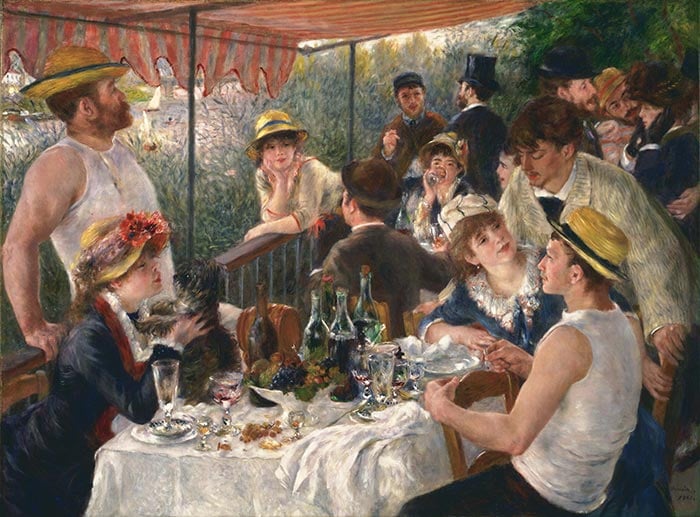
Pierre-Auguste Renoir, Luncheon of the Boating Party, 1880-1881
Asymmetrical Compositions
Inspired by the then newly developed medium of photography, the Impressionists produced paintings with unusual visual angles that resembled images of moments in time. This is why many Impressionist paintings feature asymmetrical compositions resembling aboveboard photographs taken without the knowledge of their subjects.
This is peculiarly visible in the works of Edgar Degas who, inspired past Japanese prints, painted ballerinas from intimate viewpoints, bringing the viewers into the close proximity of the dancers.
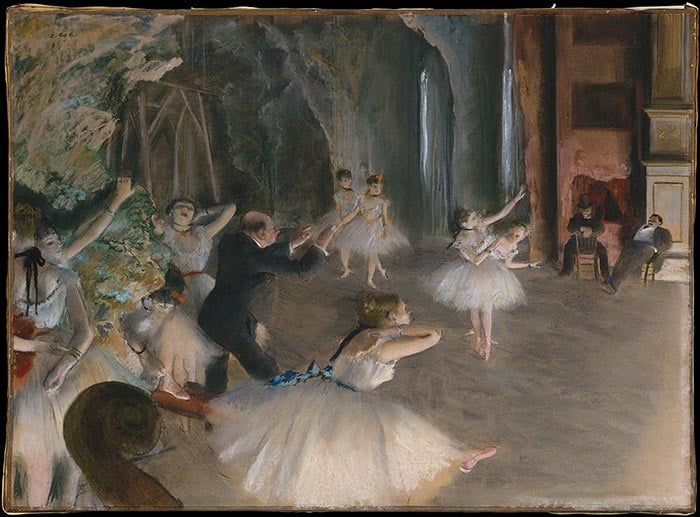
Edgar Degas, Phase Rehearsal, 1878–1879
Figureheads Of The Impressionist Art Movement
Claude Monet
The most prominent artist of the Impressionist fine art motion was undoubtedly Claude Monet, most famous for his depictions of h2o lilies.
Past using unmixed pigment and scattered brushstrokes, Monet sought to capture nature as he saw and experienced it. He often used the wet-on-wet method which involved painting one layer of paint over the other, without waiting for the outset layer to dry out. This method allowed him to complete paintings relatively rapidly compared to the wet-on-dry method which was popular at the fourth dimension.
The technique resulted in softer edges and blurred lines that but implied three-dimensional planes without realistically depicting them. As mentioned earlier, his innovative approach to art included painting the same scene over and over once more, at different times of the day and various weather weather condition to show how light and atmosphere influence our perception.
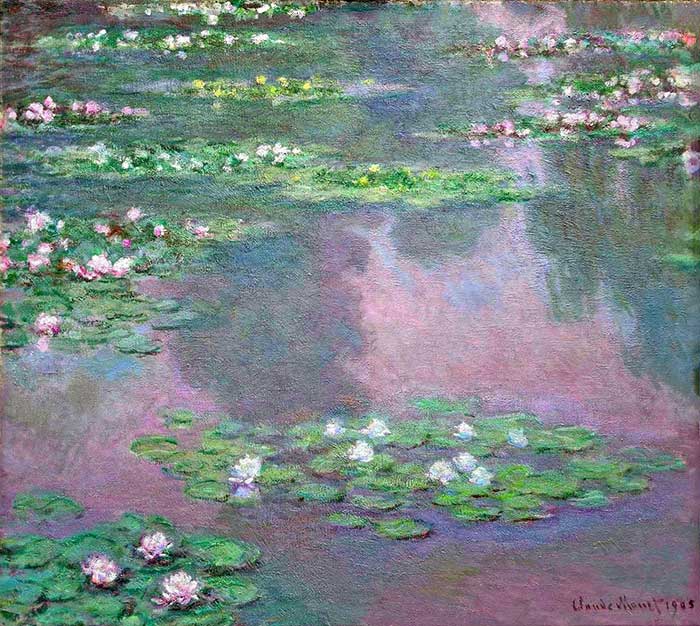
Claude Monet, Water Lilies, 1905
Camille Pissarro
Monet's friend and contemporary, Camille Pissarro, was a pivotal figure in the Impressionist movement and is known for depicting vibrant landscapes and scenes from the everyday life of French peasants. He often blended the peasant figures into the surround instead of having the figures stand out. That way he managed to go the viewers to experience the painting as a whole, instead of focusing on the subjects of the artwork.
Much similar Monet, Pissarro likewise created numerous studies of colour and low-cal past painting various rural objects nether different weather condition conditions and changing light.
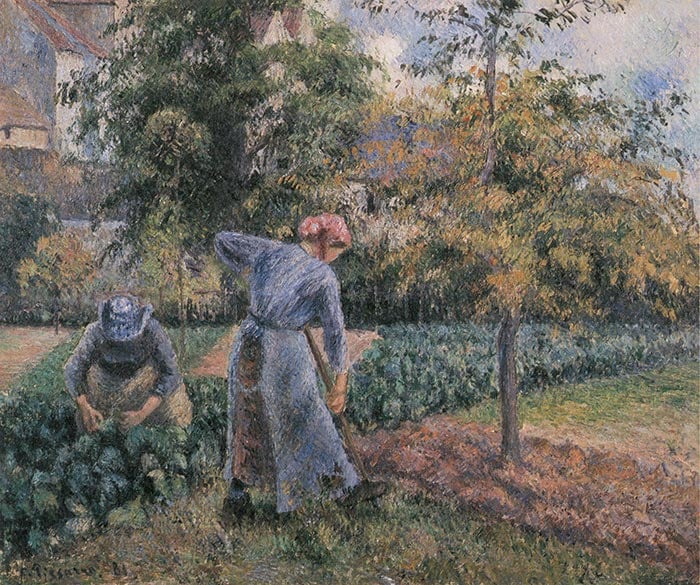
Camille Pissarro, Peasant Adult female Digging, the Jardin de Maubuisson, Pontoise, 1881
Edgar Degas
Different nearly Impressionists who preferred painting in plein air, Edgar Degas was more interested in depicting indoor scenes of people's daily activities. This is why cafes, musicians and most notably ballet dancers are unremarkably featured in his works. Inspired by the aesthetics of Japanese prints, Degas frequently experimented with unusual viewpoints and compositions. The creative person, who was besides a prolific sculptor, ofttimes used pastels to give his figures almost a sculptural quality.

Edgar Degas, Stage Rehearsal, 1878–1879
Pierre-Auguste Renoir
Celebrated for his vivid depictions of Parisian modernity and leisure activities in the tardily 19th century, he masterfully played with light and shadow to create dynamic artworks. Renoir's broken brushwork and bright colors portrayed pleasant, lighthearted topics, like gatherings of friends and female nudes.
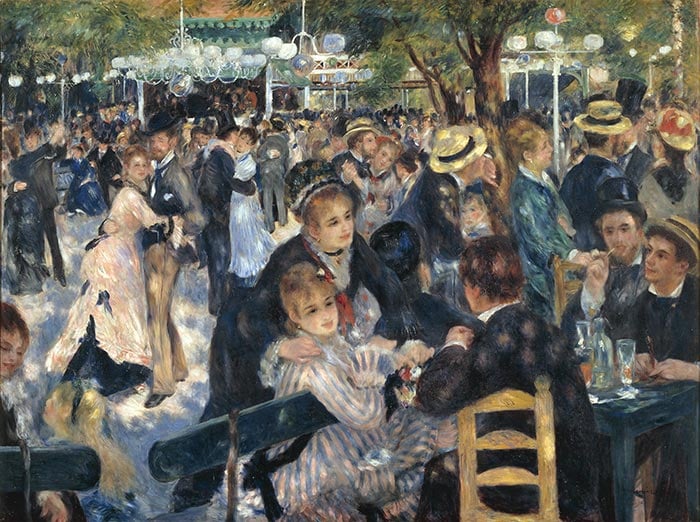
Pierre-Auguste Renoir, Dance at Le moulin de la Galette, 1876
Berthe Morisot & Mary Cassatt
Berthe Morisot, the showtime woman to exhibit with the Impressionists, rose to prominence by painting rich compositions that highlighted the domestic lives of women of the time. Her paintings often included nudes, still lifes and portraits of her girl Julie who was the creative person's favorite model.
Following an invitation by her friend and mentor Edgar Degas, American painter Mary Cassatt joined the Impressionists around 1877. The artist is renowned for her vibrant depictions of mothers taking care of their children and other everyday scenes of domestic life at the time (knitting, reading, drinking tea, etc).
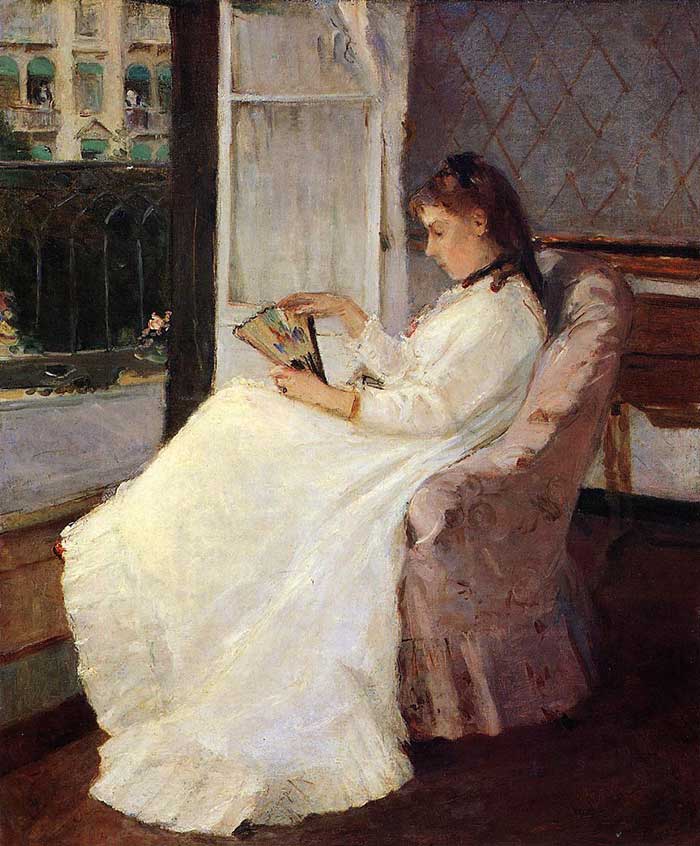
Berthe Morisot, The Creative person'south Sis at a Window, 1969
Cassatt combined Impressionism with the influence of Japanese prints and traditional techniques of old masters to create works that articulated the complex relationship between women and children. But dissimilar the onetime masters who represented the female course in a very flattering manner, Cassatt depicted women for who they were, without adornment or beautification.
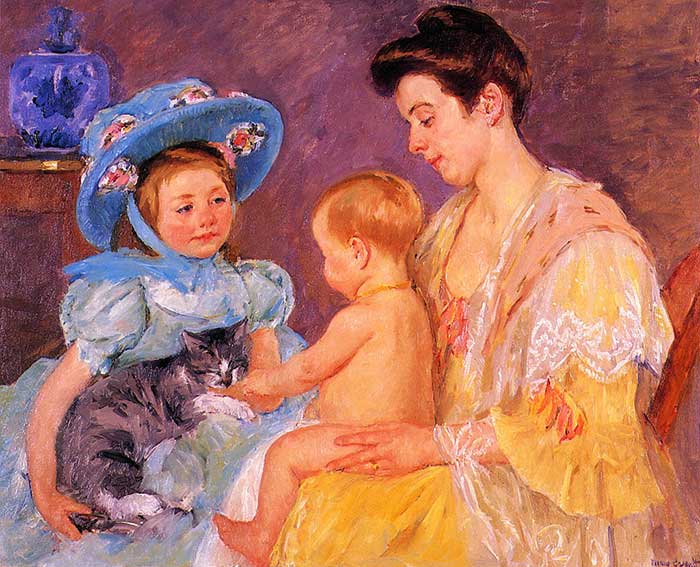
Mary Cassatt, Children Playing With A Cat, 1908
What You Tin can Acquire From The Impressionists
At that place are many things you can learn from the Impressionists, even if y'all do not favor the fashion:
- You do not need to pigment subjects with deep underlying meanings. You tin can paint flowers merely considering you recall they are pretty. This places a focus on painting technique over subject matter.
- Yous can create a vibration of colour past using the broken color technique. This also allows yous to blend subjects with the background similar Camille Pissarro did in many of his paintings.
- You do not need to resort to blacks and browns for shadows. You can use dejection, purples, greens then on. This is a much more than flexible approach to color and results in more than colorful displays.
- Yourimpression of the subject is important and unique. This is the reason why two artists can paint the aforementioned subject field, but end upwardly with completely different paintings.
(If you desire to learn more than about landscape painting, make sure to grab my free Landscape Painting Starter Kit).
Relevant Readings
Source: https://drawpaintacademy.com/impressionist-art-movement/
0 Response to "What Observations on Color Were Incorporated Into Impressionist Art"
Post a Comment